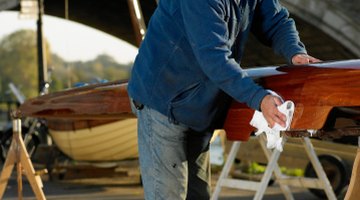How to Make Wood Smooth With Varnish
For those who’ve never refinished a piece of wooden furniture, or used varnish at all, the process can seem intimidating. But following a few basic steps, safety precautions and having a good deal of patience, the surface of a dull piece of wood can be made shiny, smooth and beautiful.

Things You Will Need
- Sandpaper (120 grit)
- Protective eyewear (safety goggles)
- Particle mask
- Wood filler
- 3-inch putty knife
- Denatured alcohol or other de-glosser
- Paintbrush
- Steel wool (# 2)
- Brown paper bag
- Wax
-
Sand the wood with a fine-grit sandpaper to remove all old varnish, oil and loose debris. It’s critical to sand the wood completely smooth before applying any varnish. Sand down any knots, dings or irregular textures. Sand in one direction and always with the grain of the wood. Be sure to wear safety goggles and a particle mask.
-
Apply wood filler with a putty knife over and into any fissures or cracks that are present in the wood surface. Sand with the fine-grit sandpaper when dry.
-
Saturate a cotton rag with denatured alcohol to de-gloss the sanded wood surface and remove residual dust particles or other debris. Let it sit overnight or until thoroughly dry. You can also use a de-glosser, though most de-glossing products have volatile fumes that can be difficult to work around.
-
Paint the varnish onto the wood using a good quality paintbrush. Apply in thin layers, in one direction, with the grain of the wood. Never go against the grain. Be sure the brush you purchase for this project is labeled for varnishing. For smaller projects use a 2-inch brush and a 4-inch one for larger projects. Let the first layer of varnish dry completely. Check the manufacturer’s instructions for drying time. Some varnishes contain chemicals that speed up the drying process, but as a rule leave it to dry overnight.
-
Sand the dry varnished surface with steel wool in order to remove the shine from the varnished surface. Do not over-sand -- do just enough to dull the surface slightly. There should be no shine when you’re finished with this step.
-
Wipe the surface down again with denatured alcohol to remove dust particles. Let it dry completely.
-
Paint a second coat of varnish onto the clean surface in the same manner described in step 4. Leave it to dry overnight.
-
Sand the dry varnished surface again with the steel wool, as in step 5.
-
Wipe the surface again with the denatured alcohol.
-
Paint a third coat of varnish onto the clean surface.
-
Rub down the varnished surface with a plain brown paper bag. Use it as though it were sandpaper. This will give the surface a nice clean shine. Be sure there is no print on the paper bag, as you sometimes see on bags from supermarkets or hardware stores.
-
Apply a generous coat of wax to the surface using a clean, soft lint-free cloth to give your wood surface a final shine. Apply the wax in one direction, with the grain of the wood. Minwax is ideal for this, but any furniture wax will suffice.
Tip
Do not rush the process. Allowing each coat to dry completely before beginning another coat is critical to achieving a high-quality varnish finish. Three coats of varnish is enough to give you positive results, but you can apply more, following steps 4, 5 and 6, if you prefer a deeper shine. Spray varnish is not recommended. But if you do use a spray varnish instead of a paint-on varnish, follow all the same steps and spray the varnish on in thin layers. Be sure not to coat too heavily or you may end up with pools or drips of varnish. Work in a roomy space where you can leave the project for a few days without it having to be touched or moved.
Warning
Always wear a mask and protective goggles when sanding to prevent breathing in dust particles and to keep your eyes free from debris. Work in a well-ventilated area, outdoors if possible, to minimize the inhalation of noxious fumes.
References
Tips
- Do not rush the process. Allowing each coat to dry completely before beginning another coat is critical to achieving a high-quality varnish finish.
- Three coats of varnish is enough to give you positive results, but you can apply more, following steps 4, 5 and 6, if you prefer a deeper shine.
- Spray varnish is not recommended. But if you do use a spray varnish instead of a paint-on varnish, follow all the same steps and spray the varnish on in thin layers. Be sure not to coat too heavily or you may end up with pools or drips of varnish.
- Work in a roomy space where you can leave the project for a few days without it having to be touched or moved.
Warnings
- Always wear a mask and protective goggles when sanding to prevent breathing in dust particles and to keep your eyes free from debris.
- Work in a well-ventilated area, outdoors if possible, to minimize the inhalation of noxious fumes.
Writer Bio
Dana Mial McMahon's writing career began in 1999 while working for a major pharmaceutical company in Cambridge, Mass., where she wrote technical guides and cross-functional instructional guides. She is publishing a children's book series called "Lemonade, Marmalade and Jam." She has also written for Lovey Girl Designs. McMahon holds a Bachelor of Science in natural science from Worcester State College.
Photo Credits
- Michael Blann/Digital Vision/Getty Images
- Michael Blann/Digital Vision/Getty Images
More Articles



